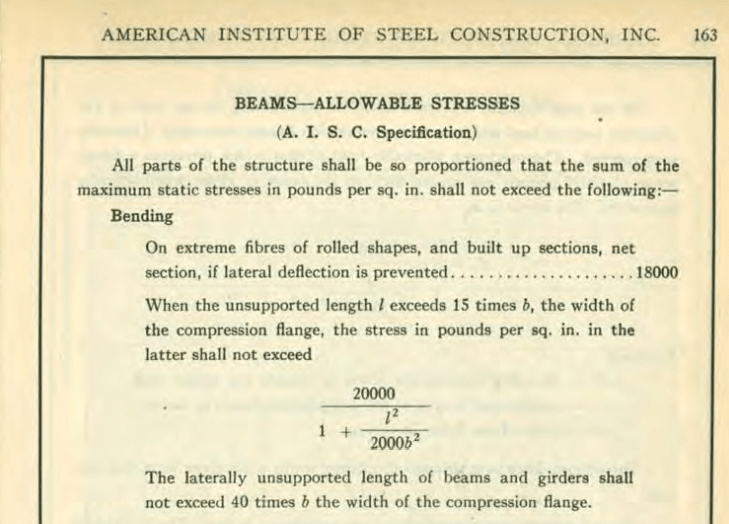Afternoon all,
So I wanted to get your opinions on using the 1st edition of the AISC manual. We have a historical building that we need to analyze, I've been told that the yield strength for the steel is 30 ksi, also, I see on the general notes that the steel is ASTM A7-58T (can't find the specifics of this online). After perusing the 1st edition manual (which I believe based on the time of construction would've used this edition), I see that the allowable bending stress is 18 ksi, they also give tables of maximum moment based on the bracing conditions. My question is this: what is the Fy assumption here? I may have missed it, but giving an allowable stress means that there is a safety factor built into the 18 ksi but it doesn't really go into specifics that I'm seeing, it just basically says you can use an allowable stress of 18 ksi. If I were to use the contemporary ASD safety factor of 1.67 on my 30 ksi yield stress I would get almost exactly 18 ksi (it's like 17.96), I want to make sure I understand their assumptions before I use their maximum moments in the tables.
Any tips would be appreciated, Thanks!

So I wanted to get your opinions on using the 1st edition of the AISC manual. We have a historical building that we need to analyze, I've been told that the yield strength for the steel is 30 ksi, also, I see on the general notes that the steel is ASTM A7-58T (can't find the specifics of this online). After perusing the 1st edition manual (which I believe based on the time of construction would've used this edition), I see that the allowable bending stress is 18 ksi, they also give tables of maximum moment based on the bracing conditions. My question is this: what is the Fy assumption here? I may have missed it, but giving an allowable stress means that there is a safety factor built into the 18 ksi but it doesn't really go into specifics that I'm seeing, it just basically says you can use an allowable stress of 18 ksi. If I were to use the contemporary ASD safety factor of 1.67 on my 30 ksi yield stress I would get almost exactly 18 ksi (it's like 17.96), I want to make sure I understand their assumptions before I use their maximum moments in the tables.
Any tips would be appreciated, Thanks!

